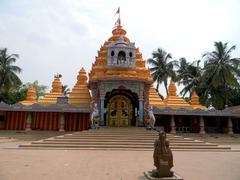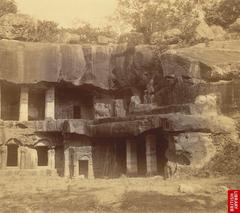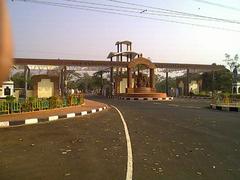Ram Mandir Bhubaneswar Visiting Hours, Tickets, and Travel Guide
Date: 04/07/2025
Introduction
Ram Mandir Bhubaneswar stands as a beacon of spiritual devotion and cultural heritage in Odisha’s vibrant capital. Established in 1979, this temple dedicated to Lord Rama, Goddess Sita, and Lord Lakshmana seamlessly blends classical Kalinga architecture with modern amenities. Its saffron-painted spires and intricate red sandstone carvings make it both a revered place of worship and a cultural hub, especially during festivals like Ram Navami, Dussehra, and Janmashtami. Conveniently located in Kharavel Nagar, near major transport links, Ram Mandir welcomes visitors with wheelchair access, guided tours, tranquil gardens, and a warm, inclusive atmosphere. This comprehensive guide details everything you need to know for a meaningful visit, from history and rituals to practical travel tips and nearby attractions. For more, see Bhakti Bharat, TravelSetu, and Bhubaneswar Tourism.
Table of Contents
- Historical Background and Religious Significance
- Architectural and Artistic Features
- Religious Life, Festivals, and Rituals
- Visitor Information: Hours, Tickets, and Facilities
- Travel Tips
- Nearby Attractions
- Local Flavors and Festivities
- Safety, Etiquette, and Accessibility
- Frequently Asked Questions (FAQ)
- Conclusion and Final Tips
- Sources and Further Reading
Historical Background and Religious Significance
Origins and Construction
Ram Mandir, consecrated on 27 June 1979, is a relatively modern addition to Bhubaneswar’s famed temple landscape (Bhakti Bharat). Built by the Rama Mandir Trust (Kalinga Foundation Trust), the temple was envisioned as an accessible center for Lord Rama worship and Ramayana-centric festivities, bridging traditional faith with the city’s dynamic growth (TravelSetu).
Religious and Cultural Role
The temple honors Lord Rama, Sita, and Lakshmana as its central deities, symbolizing dharma, familial harmony, and devotion. Additional shrines for Hanuman, Shiva, and Durga underscore the temple’s inclusive spirit (Wikipedia). Ram Mandir has evolved into a vital hub for Vaishnavite worship and a focal point for community celebrations, daily rituals, and spiritual discourses.
Architectural and Artistic Features
Kalinga Style and Design
Ram Mandir’s architecture draws heavily from the traditional Kalinga style, characterized by:
- Saffron-Painted Shikharas: Three striking spires dominate the skyline, symbolizing spiritual ascent and drawing the eye from afar (Trends450).
- Red Sandstone Construction: The use of local sandstone, adorned with intricate carvings and mythological motifs, connects the temple to Odisha’s ancient building traditions (Acharya Ganesh).
- Marble Idols and Interiors: The main sanctum features marble idols of Lord Rama, Sita, and Lakshmana, with subsidiary shrines for other deities (Odisha Visit).
- Gardens and Courtyards: Landscaped gardens and open courtyards provide spaces for meditation and festival gatherings (Holiday Landmark).
Accessibility and Layout
The complex is designed to be accessible, with ramps for differently-abled visitors, clean restrooms, and drinking water stations. The elevated plinth and spacious courtyards enhance the temple’s visual and functional appeal (InBhubaneswar).
Religious Life, Festivals, and Rituals
Daily Worship
- Mangala Aarti: Early morning prayers mark the start of temple activities.
- Sandhya Aarti: Evening rituals with devotional singing and recitations from the Ramayana.
- Special Puja and Abhisheka: Conducted on request or during special occasions.
Major Festivals
The temple is renowned for its grand festivities, including:
- Ram Navami: Marks the birth of Lord Rama with elaborate rituals, bhajans, and community feasting (Trodly).
- Diwali (Deepavali): The temple is illuminated with thousands of diyas, creating a mesmerizing spectacle.
- Dussehra: Features Ramayana recitations and symbolic effigy burning.
- Janmashtami: Celebrates Lord Krishna’s birth with midnight vigils and cultural performances.
- Makar Sankranti and Pana Sankranti: Observed with special prayers and traditional foods (Hindu Calendar).
- Vivaha Panchami, Shivaratri, Raksha Bandhan: Each festival is marked by unique rituals and vibrant community participation.
Cultural and Community Activities
- Bhajan and Kirtan Evenings: Regular devotional music sessions enrich the spiritual ambiance.
- Spiritual Discourses: Scholars and priests share teachings from the Ramayana and other scriptures.
- Youth Engagement: Competitions, storytelling, and educational activities during festivals.
- Annadanam: Free community meals, especially during festivals, foster inclusivity and service.
Visitor Information: Hours, Tickets, and Facilities
Visiting Hours
- Daily: 5:00 AM – 9:00 PM (some sources note 6:00 AM – 9:00 PM; festival hours may be extended)
- Aarti Timings: Mangala Aarti (4:00 AM), Shingara Aarti (6:15 AM), Sayan Aarti (10:00 PM) (eBhubaneswar)
Entry and Tickets
- Entry Fee: Free for all visitors; donations are welcomed.
- Special Pujas: Some rituals or sponsored events may require prior registration or donation.
Guided Tours and Photography
- Guided Tours: Available on request, especially during festivals.
- Photography: Permitted in the outer precincts; restricted inside the sanctum. Always confirm with temple staff.
Directions and Access
- Address: 1, Madhusudan Marg, Ekamra Vihar, UNIT-9, Bhubaneswar, Odisha 751001
- By Air: Biju Patnaik International Airport (4.7 km)
- By Train: Bhubaneswar Railway Station (1.4 km)
- By Road: Well connected via city roads, public buses, taxis, and auto-rickshaws (TravelTriangle, TFIGlobalNews)
Facilities
- Restrooms and Drinking Water: Available on-site.
- Shops: Stalls offer religious items, souvenirs, and snacks.
- Wheelchair Access: Ramps and assistance provided.
- Security: Staffed, with checks during festivals.
Travel Tips
- Best Time to Visit: Early mornings or late evenings for peaceful darshan; festivals for vibrant experiences.
- Dress Code: Modest attire covering shoulders and knees; remove footwear at the entrance.
- Language: Odia is widely spoken; Hindi and English are commonly understood by staff.
- Weather: Summer months (April–June) can be hot; carry water and dress appropriately.
- Personal Safety: Keep valuables secure, especially during crowded festivals.
Nearby Attractions
Ram Mandir’s central location makes it an ideal starting point to explore Bhubaneswar’s rich heritage:
- Lingaraj Temple: 11th-century Shiva temple, 2–3 km away.
- Mukteswara Temple: Renowned for stone carvings, about 3.5–4 km away.
- Rajarani Temple: Unique architecture, 2–3 km distance.
- Ananta Vasudeva Temple: Vaishnavite temple, 3 km away.
- Orissa State Museum, Indira Gandhi Park, Museum of Tribal Arts & Artifacts: All within a 5 km radius.
(TFIGlobalNews, TravelTriangle)
Local Flavors and Festivities
During festivals, stalls outside the temple serve classic Odia sweets such as Pithas, Rasabali, Chenna Gaja, and Chenna Poda—often distributed as prasad (Bhubaneswar Tourism). Community meals (annadanam) are a highlight, fostering unity and inclusivity.
Safety, Etiquette, and Accessibility
- COVID-19 Protocols: Mask-wearing, hand sanitizing, and social distancing may be in effect.
- Cleanliness: Maintain the temple’s high standards by using bins and minimizing plastic.
- Mobile Phones: Keep phones on silent; avoid calls within the temple.
- Lost and Found: Report lost items to the temple office or security.
Frequently Asked Questions (FAQ)
Q1: What are the Ram Mandir Bhubaneswar visiting hours?
A1: The temple is open daily from 5:00 AM to 9:00 PM. Festival hours may be extended.
Q2: Is there an entry fee or ticket required?
A2: Entry is free for all visitors; donations are optional.
Q3: Are guided tours available?
A3: Yes, especially during festivals. Contact the temple office or local tour operators.
Q4: Is the temple accessible for differently-abled visitors?
A4: Yes, with ramps and assistance available, though some areas may require help.
Q5: Can I take photographs inside the temple?
A5: Photography is allowed in the outer precincts but restricted inside the sanctum. Always ask for permission.
Q6: What is the dress code?
A6: Modest attire recommended; shoulders and knees should be covered. Shoes must be removed before entry.
Q7: How do I reach Ram Mandir Bhubaneswar?
A7: The temple is centrally located and easily accessible by air, rail, and road.
Conclusion and Final Tips
Ram Mandir Bhubaneswar represents a harmonious blend of faith, culture, and art. Since its consecration in 1979, it has grown into a spiritual sanctuary, celebrating the timeless values of dharma and devotion through its architecture, rituals, and inclusive community programs. Its accessibility, proximity to other historic sites, and rich festival calendar make it a must-visit for devotees and tourists alike. Plan your visit by checking the temple schedule, respecting local customs, and exploring the city’s cultural heritage. For real-time updates, guided audio tours, and travel tips, download the Audiala app and follow our official channels.
Sources and Further Reading
- Bhakti Bharat
- TravelSetu
- Wikipedia
- Trends450
- Acharya Ganesh
- Holiday Landmark
- InBhubaneswar
- Bhubaneswar Tourism
- Odisha Visit
- TFIGlobalNews
- Trodly
- Hindu Calendar - Drik Panchang
- TravelTriangle
- eBhubaneswar








